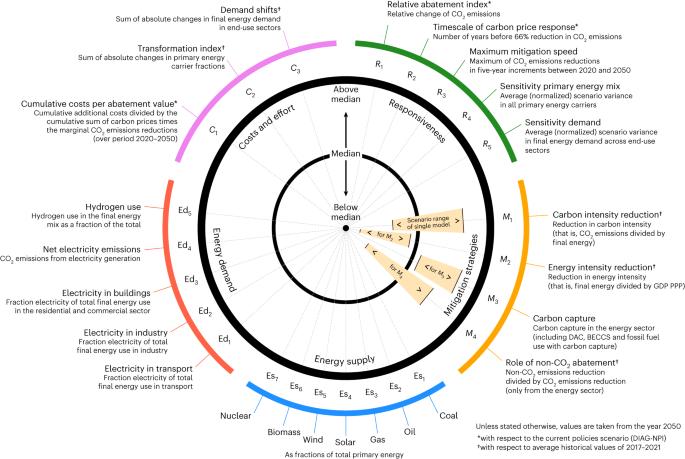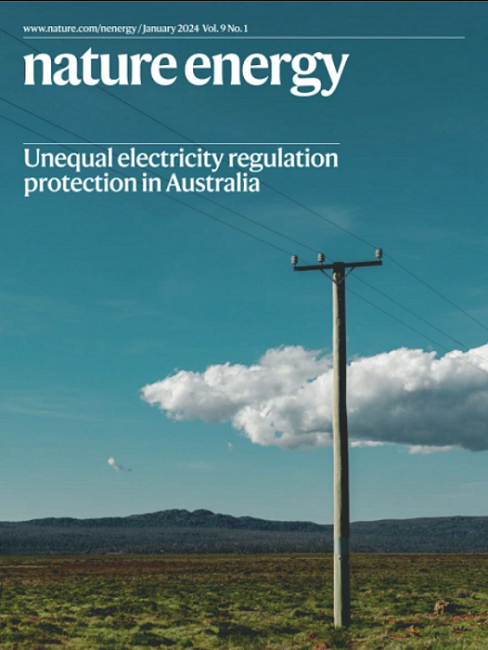Identifying energy model fingerprints in mitigation scenarios
IF 60.1
1区 材料科学
Q1 ENERGY & FUELS
引用次数: 0
Abstract
Energy models are used to study emissions mitigation pathways, such as those compatible with the Paris Agreement goals. These models vary in structure, objectives, parameterization and level of detail, yielding differences in the computed energy and climate policy scenarios. To study model differences, diagnostic indicators are common practice in many academic fields, for example, in the physical climate sciences. However, they have not yet been applied systematically in mitigation literature, beyond addressing individual model dimensions. Here we address this gap by quantifying energy model typology along five dimensions: responsiveness, mitigation strategies, energy supply, energy demand and mitigation costs and effort, each expressed through several diagnostic indicators. The framework is applied to a diagnostic experiment with eight energy models in which we explore ten scenarios focusing on Europe. Comparing indicators to the ensemble yields comprehensive ‘energy model fingerprints’, which describe systematic model behaviour and contextualize model differences for future multi-model comparison studies. Energy models play a crucial role in studying mitigation strategies; however, substantial variations among these models exist. This study presents a typology for energy models to map these model differences, based on five dimensions, each characterized by numerous diagnostic indicators.

识别缓解场景中的能源模型指纹
能源模型用于研究减排途径,例如与《巴黎协定》目标相一致的途径。这些模型在结构、目标、参数化和详细程度上各不相同,导致计算的能源和气候政策情景存在差异。为了研究模型差异,诊断指标在许多学术领域都是常见的做法,例如在物理气候科学领域。然而,除了解决单个模型维度之外,它们尚未在缓解文献中得到系统应用。在这里,我们通过量化五个维度的能源模型类型来解决这一差距:响应能力、缓解策略、能源供应、能源需求以及缓解成本和努力,每一个都通过几个诊断指标来表达。该框架被应用于一个有八个能源模型的诊断实验,在该实验中,我们探索了以欧洲为重点的十种场景。将指标与集合进行比较会产生全面的“能量模型指纹”,它描述了系统的模型行为,并为未来的多模型比较研究提供了模型差异的背景。
本文章由计算机程序翻译,如有差异,请以英文原文为准。
求助全文
约1分钟内获得全文
求助全文
来源期刊

Nature Energy
Energy-Energy Engineering and Power Technology
CiteScore
75.10
自引率
1.10%
发文量
193
期刊介绍:
Nature Energy is a monthly, online-only journal committed to showcasing the most impactful research on energy, covering everything from its generation and distribution to the societal implications of energy technologies and policies.
With a focus on exploring all facets of the ongoing energy discourse, Nature Energy delves into topics such as energy generation, storage, distribution, management, and the societal impacts of energy technologies and policies. Emphasizing studies that push the boundaries of knowledge and contribute to the development of next-generation solutions, the journal serves as a platform for the exchange of ideas among stakeholders at the forefront of the energy sector.
Maintaining the hallmark standards of the Nature brand, Nature Energy boasts a dedicated team of professional editors, a rigorous peer-review process, meticulous copy-editing and production, rapid publication times, and editorial independence.
In addition to original research articles, Nature Energy also publishes a range of content types, including Comments, Perspectives, Reviews, News & Views, Features, and Correspondence, covering a diverse array of disciplines relevant to the field of energy.
 求助内容:
求助内容: 应助结果提醒方式:
应助结果提醒方式:


